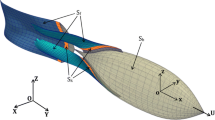Abstract
Numerical simulation of a flow past an undulating two-dimensional fish-like body is carried out by using Lattice Boltzmann Method (LBM) and our newly-proposed immersed Boundary Velocity Correction Method (IBVCM). The fish body used in the simulation is constructed from the NACA0012 airfoil. Based on the kinematics for undulatory swimming fish, the midline of the fish-like body oscillates transversally in the form of traveling wave. The current study is focused on the effects of Reynolds number and the character of midline oscillation on the generation of propulsion force. The investigation indicates that the higher Reynolds number, or higher frequency, or higher amplitude of midline oscillation produces a higher propulsion force. Among the parameters affecting the generation of propulsion force, the amplitude of midline oscillation is the most noticeable factor.
Similar content being viewed by others
References
Alexander, R. McN., 2003, “Principles of Ani-mal Locomotion,”Princeton:Princeton University Press.
Colgate, J. E. and Lynch, K. M., 2004, “Me-chanics and Control of Swimming: a Review,”IEEE J. of Oceanic Engineering, Vol. 29(3), p. 660.
Koochesfahani, M. M., 1989, “Vortical Patterns in the wake of an Oscillating Airfoil,”AIAA J., Vol. 27(9), p. 1200.
Lighthill, M. J., 1960, “Note on the Swimming of Slender Fish,”J. Fluid Mech., Vol. 9, p. 305.
Liu, H. and Kawachi, K., 1999, “A numerical Study of Undulatory Swimming,”J. Comput. Phys., Vol. 155, p. 223.
Liu, H., Wassersug, R. and Kawachi, K., 1996, “A Computational Fluid Dynamic Study of Tad-pole Swimming,”J. Exp. Biol., Vol. 199(6), p. 1024.
McDiarmid, R. W. and Altig, R., 1999,Tadpoles: the biology of anuran larvae. Chicago and London: University of Chicago Press.
Newman, J. N., 1973, “The Force on a Slender Fishlike Body,”J. Fluid Mech., Vol. 58(4), p. 689.
Peskin, C. S., 1977, “Numerical Analysis of Blood Flow in the Heart,”J. Comp. Phys., Vol. 25, p. 220.
Schultz, W. W. and Webb, P. W., 2002, “Power Requirements of Swimming: do new Methods Resolve Old Questions?”Integr. Comp. Biol., Vol. 42, p. 1018.
Sfakiotakis, M., Lane, D. M. and Davies, J. B. C., 1999, “Review of fish swimming Modes for Aquatic Locomotion,”IEEE J. Oceanic Eng., Vol. 24, p. 237.
Shu, C., Niu, X. D. and Chew, Y. T., 2002, “Taylor Series Expansion-and least Square-based Lattice Boltzmann Method: Two-Dimensional For-mulation and its Applications,”Phys. Rev. E 65, 036708.
Triantafyllou, G. S., Triantafyllou, M. S. and Grosenbaugh, M. A., 1993, “Optimal Thrust Development in Oscillating foils with Application to Fish Propulsion,”J. Fluid Struct., Vol. 7, p. 205.
Videler, J. J.,Fish Swimming, Chapman & Hall, London.
Wassersug, R. and Hoff, K., 1985, “The Ki-nematics of Swimming in Anuran Larvae,”J. Exp. Biol., Vol. 119, p. 1.
Author information
Authors and Affiliations
Corresponding author
Rights and permissions
About this article
Cite this article
Shua, C., Liua, N., Chewa, Y. et al. Numerical simulation of fish motion by using lattice Boltzmann-Immersed Boundary Velocity Correction Method. J Mech Sci Technol 21, 1352 (2007). https://doi.org/10.1007/BF03177420
Received:
Revised:
Accepted:
DOI: https://doi.org/10.1007/BF03177420



